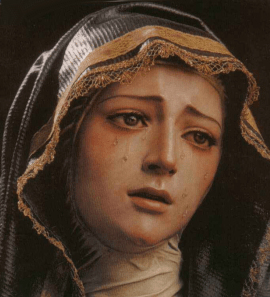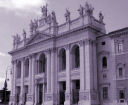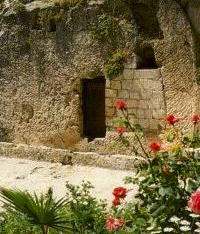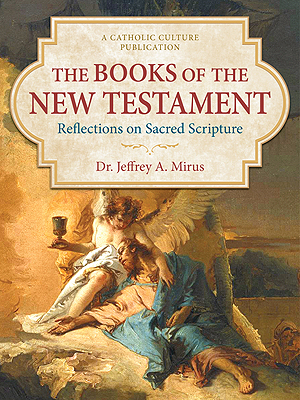» Enjoy our Liturgical Seasons series of e-books!
On Holy Saturday the Church waits at the Lord's tomb, meditating on his suffering and death. The altar is left bare, and the sacrifice of the Mass is not celebrated. Only after the solemn vigil during the night, held in anticipation of the resurrection, does the Easter celebration begin, with a spirit of joy that overflows into the following period of fifty days.
Holy Saturday
Holy Saturday (from Sabbatum Sanctum, its official liturgical name) is sacred as the day of the Lord's rest; it has been called the "Second Sabbath" after creation. The day is and should be the most calm and quiet day of the entire Church year, a day broken by no liturgical function. Christ lies in the grave, the Church sits near and mourns. After the great battle He is resting in peace, but upon Him we see the scars of intense suffering...The mortal wounds on His Body remain visible...Jesus' enemies are still furious, attempting to obliterate the very memory of the Lord by lies and slander.
 Mary and the disciples are grief-stricken, while the Church must mournfully admit that too many of her children return home from Calvary cold and hard of heart. When Mother Church reflects upon all of this, it seems as if the wounds of her dearly Beloved were again beginning to bleed.
Mary and the disciples are grief-stricken, while the Church must mournfully admit that too many of her children return home from Calvary cold and hard of heart. When Mother Church reflects upon all of this, it seems as if the wounds of her dearly Beloved were again beginning to bleed.
According to tradition, the entire body of the Church is represented in Mary: she is the "credentium collectio universa" (Congregation for Divine Worship, Lettera circolare sulla preparazione e celebrazione delle feste pasquali, 73). Thus, the Blessed Virgin Mary, as she waits near the Lord's tomb, as she is represented in Christian tradition, is an icon of the Virgin Church keeping vigil at the tomb of her Spouse while awaiting the celebration of his resurrection.
The pious exercise of the Ora di Maria is inspired by this intuition of the relationship between the Virgin Mary and the Church: while the body of her Son lays in the tomb and his soul has descended to the dead to announce liberation from the shadow of darkness to his ancestors, the Blessed Virgin Mary, foreshadowing and representing the Church, awaits, in faith, the victorious triumph of her Son over death.
—Directory on Popular Piety and the Liturgy
Although we are still in mourning, there is much preparation during this day to prepare for Easter. Out of the kitchen comes the smells of Easter pastries and bread, the lamb or hams and of course, the Easter eggs.
There are no liturgies celebrated until the Easter Vigil. Some local parish priests bless the food baskets on this day. In Slavic countries there is a blessing of the traditional Easter foods, prepared in baskets: eggs, ham, lamb and sausages, butter and cheeses, horseradish and salt and the Easter breads. The Easter blessings of food owe their origin to the fact that these particular foods, namely, fleshmeat and milk products, including eggs, were forbidden in the Middle Ages during the Lenten fast and abstinence. When the feast of Easter brought the rigorous fast to an end, and these foods were again allowed at table, the people showed their joy and gratitude by first taking the food to church for a blessing. Moreover, they hoped that the Church's blessing on such edibles would prove a remedy for whatever harmful effects the body might have suffered from the long period of self-denial. Today the Easter blessings of food are still held in many churches in the United States, especially in Slavic parishes.
If there is no blessing for the Easter foods in the parish, the father of the family can pray the Blessing over the Easter foods.
The entire celebration of the Easter Vigil must take place during the night, so that it begins after nightfall and ends before daybreak on the Sunday. See further details on the Easter Vigil Liturgy.
Highlights and Things to Do:
- Today we remember Christ in the tomb. The day is usually spent working on the final preparations for the biggest feast of the Church year. The list of suggested activities is long, but highlights are decorating Easter eggs and attending a special Easter food blessing.
- For families with smaller children, you could create a miniature Easter garden, with a tomb. The figure of the risen Christ will be placed in the garden on Easter morning.
- Another activity for families is creating a paschal candle to use at home. See Family in Feast and Feria, Jennifer Gregory Miller's personal blog for an easy Paschal candle graphic to use to make a candle for home.
- The Directory on Popular Piety discusses some of the various devotions related to Easter, including the Blessing of the Family Table, Annual Blessing of Family Home, the Via Lucis and the Visit to the Mother of the Risen Christ.
Meditation on the Easter Vigil:
During the Easter Vigil, the Church awaits its "blessed hope, the appearing of the glory of our great God and Savior, Jesus Christ, who gave himself for us to redeem us from all iniquity and to purify himself a people of his own who are zealous for good deeds" [Titus 2.13-14]. The Church's waiting is both historical and eschatological, both "then" and "future": with the holy women, we await the dawn of Resurrection and the announcement that the Lord is risen indeed; as the Church today, we await his return in glory, which will complete the drama of salvation history and inaugurate the Wedding Feast of the Lamb in its full splendor.
The readings at the Easter Vigil, which follow the lighting of the paschal candle and the singing of the Exultet, make present in word and imagination the crucial moments in salvation history: Creation, culminating in the breath of life being given to man and woman, images of the Creator in themselves and in their communion; the testing of Abraham, whose obedience made him our "father in faith"; the exodus from Egypt and the liberation of the chosen people from slavery and its death-dealing habits; Isaiah's visions of a world made aright in justice and peace, a world of bounty freely given and gratefully received; Baruch's testimony to the divine wisdom in giving humanity the law that liberates; Ezekiel's exilic prophecy of a people of God cleaned from impurity, whose "heart of stone" will be replaced by a "heart of flesh."
After these readings, best proclaimed with the lights dimmed, the Church anticipates the proclamation of the Lord's Resurrection by singing the Gloria, during which bells are rung and the church fully illuminated. Now, in anticipation of the baptismal liturgy that will shortly follow, the Church reads Paul's reminder to the Romans that "all of us who have been baptized into Christ Jesus have been baptized into his death." This dying with Christ is no mere recapitulation; rather, it is a sacramental living out of what the Church has pondered throughout this day and anticipates in its Easter celebration: "We were buried therefore with him by baptism into death, so that as Christ was raised from the dead by the glory of the Father, we too might walk in newness of life."
The gospel reading at the Easter Vigil varies according to the three-year Lectionary cycle. Each of these Synoptic gospel selections ends on a note of surprise and puzzlement: it will take time for the holy women and the remaining eleven disciples to understand the meaning of the empty tomb and the angelic message there. Read today, with the eyes of faith, the initial incomprehension of those closest to Jesus is a reminder that every disciple must grow in a knowledge of the Resurrection and in an appreciation of what Easter faith truly means.
Pope Francis stressed this note of surprise in his first Easter Vigil homily as Bishop of Rome, noting that, as it was with the apostles and the holy women, "Newness often makes us fearful, including the newness which God brings us, the newness that God asks of us." Easter calls us beyond such fears, though: "Dear brothers and sisters, let us not be closed to the newness that God wants to bring into our lives! Are we often weary, disheartened, and sad? Do we feel weighed down by our sins? Do we think that we won't be able to cope? Let us not close our hearts, let us not lose confidence, let us never give up." For Easter faith teaches us that "there are no situations which God cannot change, there is no sin which he cannot forgive if only we open ourselves to him."
—George Weigel, Roman Pilgrimage: The Station Churches

Holy Saturday--Easter Vigil of the Sacred Triduum
Station with San Giovanni in Laterano (St. John Lateran):
The Station returns again to St. John Lateran. During the afternoon of Holy Saturday the faithful were summoned here for the final scrutiny of the catechumens. Then, in the evening began the vigil or night of watching which concluded at dawn with the solemn baptisms—-the neophytes, plunged into the baptismal waters and there buried with Christ, were born to the life of grace at the very time when our Savior came forth triumphant from the tomb at dawn on Easter morning.
For more on San Giovanni in Laterano, see:
For further information on the Station Churches, see The Stational Church.






